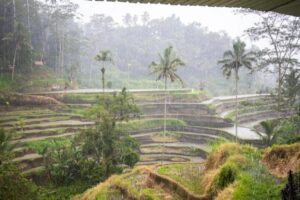Taman Beji Griya Waterfall is a peaceful, hidden gem in Punggul Village, Abiansemal, Badung, Bali. It’s not only known for its stunning waterfall views but also for offering a deep spiritual experience through self-purification rituals.
More than just a scenic spot, Taman Beji Griya Waterfall is part of a sacred temple area, surrounded by lush tropical greenery. Here, visitors can take part in Melukat, a traditional Balinese Hindu cleansing ritual meant to wash away negative energy and refresh the body and soul.
Table of Contents
ToggleLocation and Access Taman Beji Griya
- Where it is
Beji Griya Waterfall is a peaceful spiritual spot tucked away in Punggul Village, Abiansemal, Badung, Bali. It’s well-known for its Melukat ritual (a traditional Balinese self-purification ceremony) set against a beautiful natural backdrop. This destination combines sacred vibes with nature, making it one of the more unique things to do in Ubud and beyond. - How to get there
- Taman Beji Griya Waterfall to Ubud: Around 13 km, about 20–45 minutes depending on traffic.
- From Denpasar: Roughly 25 km, with a 1 to 1.5-hour drive.
- From Seminyak or Canggu: About 24 km, takes around 1 hour.
The easiest way to reach Beji Griya Waterfall is by renting a car or motorbike, as public transportation in the area is limited. If you prefer a more convenient option, several tour operators offer packages that include shuttle service with pickup from popular areas like Ubud, Kuta, or Gianyar. This can make the journey smoother, especially if you’re not familiar with local roads.
- Accessibility Notes
Getting to Taman Beji Waterfall involves walking down a set of concrete stairs through lush tropical forest. The path is scenic but can be steep and a bit slippery, especially during the rainy season, so it’s best if you’re in good physical shape.
The area is well-equipped with a spacious parking lot, changing rooms, and toilets to make your visit more comfortable. Before you go, don’t forget to check the Taman Beji Griya Waterfall ticket price, as small entrance or donation fees may apply.
What is the Melukat Ceremony?
- Explanation of Melukat
Melukat is a traditional purification ceremony in Bali, rooted in Balinese Hindu culture. The word comes from the Sanskrit “lukat,” meaning to release or cleanse.
It’s a way to clear your body, mind, and soul of negative energy, emotional burdens, and anything that throws off your inner balance. Locals and visitors alike take part in this spiritual ritual to feel lighter, more centered, and refreshed. - Cultural and religious background
Melukat is part of the Tattwa and Ethics teachings in the Hindu Dharma tradition. In Bali, it’s a real expression of Tri Kaya Parisudha, thinking, speaking, and acting with kindness. Beji Griya Waterfall is one of the places believed to hold strong natural and spiritual energy because it’s surrounded by sacred elements like rivers, waterfalls, and temples.
Part of Beji Griya Waterfall’s history, the site has long been guided by spiritual leaders and is now a popular spot for locals and travelers seeking purification and healing. - Purpose
Melukat isn’t just about pouring holy water over the body, it goes much deeper than that. The purpose is to:- Let go of negative energy, whether it comes from outside influences or from within.
- Soothe a restless, stressed-out mind and bring things back into balance.
- Open up your spiritual connection with Sang Hyang Widhi (God) and the natural elements.
- Support emotional healing by surrounding yourself with calming energy from nature and sacred prayers.
This could be an alternative to things to do in Ubud, but you can do it in other locations.
Step-by-Step Experience
- Initial prayer and offerings with a priest
The experience starts with a prayer led by a local priest (pemangku) at a small temple within the Taman Beji complex. Participants receive offerings and flowers as a sign of respect for the sacred spirits and natural surroundings. The priest then guides a quiet, personal prayer focused on purification and letting go of negative energy. - Walk through the gorge with statues and a sacred atmosphere
After the prayer, participants walk down stone steps into the river valley, symbolizing a release of worldly burdens. Along the way, sacred statues and symbols guide the path. The sound of water, lush greenery, and mist from the falls create a calm, spiritual atmosphere leading to the main purification site.
Cleansing at:
- Tamba Sunia Cave
Tamba Sunia means “medicine for solitude” or “healing inner emptiness.” Inside this natural cave, melukat participants sit in silence as holy water falls from above. This ritual is believed to help heal emotional wounds, trauma, and support fertility, both spiritually and physically. The cave’s cool, quiet setting offers a deep space for reflection, making it the most introspective part of the cleansing journey. - Rambut Sedana Spring
This spring is named after Dewi Rambut Sedana, a Balinese Hindu symbol of prosperity. Melukat at this spot is meant to clear blockages and open the flow of abundance. Many business owners, workers, and students come here with offerings, hoping for success and smooth progress. The water is believed to carry energy that aligns good intentions with blessings in work, business, and finances. - Final purification under twin waterfalls
The final stage of the Melukat ritual at Taman Beji is the cleansing under the twin waterfalls. Participants stand beneath the water while offering a final prayer, allowing the flow to wash away negative energy, past burdens, and old emotions. The twin waterfalls represent the balance of life, like joy and sorrow or good and bad, reminding us that peace comes from accepting both.
What to Prepare Before You Go
Melukat is a sacred ritual, so it’s important to be ready both physically and mentally, and to bring the right gear. This helps the whole experience flow smoothly and with respect.
- Required attire (sarong, sash)
Both men and women need to wear a sarong before entering the temple and starting the melukat ritual. A sash tied around the waist shows spiritual readiness and respect for the sacred space. You can usually rent or borrow them at the site, but bringing your own is a good idea if you have one. - Recommended items (towel, dry clothes, waterproof bag, drinking water)
Bring a dry towel and a change of clothes since you’ll get completely wet during the ritual. A dry bag is useful to keep your phone, wallet, and other personal items safe. Don’t forget drinking water to stay hydrated after the cleansing. If you have long hair, a hair tie will help keep things comfortable. - Booking in advance
It’s best to reserve ahead of time, especially if you’re coming with a group or want to be guided by a local priest. You can book through a tour agency, spiritual retreat organizer, or contact the site manager directly, often via WhatsApp. Walk-ins are sometimes allowed, but the experience might not be as smooth or personal without a reservation. - Cost or donation guidelines
There’s usually no set fee, but giving a donation (sesari) is encouraged. The amount varies, typically around IDR 50,000 to 200,000, depending on the place and what’s included. Some spots cover things like a guide, sarong, and holy water in the donation. - Etiquette and Respectful Behavior
Dress modestly and stay calm throughout the visit. Keep noise to a minimum and avoid joking around. Don’t point at or touch any statues or offerings without guidance.
Women who are menstruating are generally not allowed to take part in the rituals or enter sacred spaces. Always follow the instructions of the priest or guide, and make sure to keep the area clean by not leaving any trash behind.
Cultural dos and don’ts
- Quietness during rituals
During the Melukat ritual, it’s important to stay quiet and calm. This is a sacred and meaningful experience, so avoid loud sounds, laughter, or too much talking. Focus on your intention to cleanse yourself and fully take in the peaceful and spiritual atmosphere. - Restrictions
- Women who are menstruating are usually not allowed to take part in Melukat or enter sacred areas, as they’re considered to be in a less pure state based on Balinese Hindu beliefs.
- Photo-taking is limited. You may not be allowed to snap pictures during certain parts of the ritual, especially prayers. It’s best to check with the priest or guide first.
- Try not to take too many videos or selfies, as it can come off as disrespectful to the place and those who are there to pray.
- Environmental Considerations
- Beji parks and Melukat sites are usually set in open, sacred spaces like rivers, caves, and waterfalls that are carefully protected for their spiritual value.
- Avoid stepping on plants, throwing trash, or bringing anything into the water that might pollute the holy spring.
- Eco-friendly tips
- Bring a refillable water bottle and skip single-use plastics.
- Use a cloth bag or dry bag instead of plastic ones.
- If you bring offerings or flowers, make sure not to leave behind any plastic or wrapping.
- Avoid using too much sunscreen or lotion before entering the holy water, as it can affect the purity of the site.
Post-Ceremony Reflection
After finishing the melukat ritual, it’s common for participants to take time to reflect. Melukat isn’t just about cleansing the body, it’s also about shifting inner energy. But before diving into deep reflection, many locals take a moment to recharge their energy first.
- Recommended places to rest or reflect nearby
- You can reflect while enjoying a good meal. It helps you recharge and continue the melukat experience. A peaceful place to eat in Ubud is Norii Japanese Restaurant. The food is delicious, and the setting is calm and cozy.
- Another option is to relax with a wellness treatment like a spa session. It helps your body unwind and deepens your sense of renewal. Svaha Spa is a great choice, with several branches in Ubud. They offer not just massages but also beautiful views to enhance the experience.
- Or you can simply reflect at a tranquil accommodation such as Asvara Villa in Ubud.
- How participants typically feel after the ritual
Everyone’s experience can be different, but most people say they feel:- A sense of lightness, like something heavy has been lifted off their shoulders.
- Calmer inside, with a clearer mind.
- Some may feel unexpectedly emotional or tearful, which is totally normal and part of letting go.
- It’s also common to feel a bit tired afterward, as the ritual can move a lot of energy through the body.
Final Tips and Summary
- Who this experience is for
Melukat at Taman Beji is a great choice for anyone on a spiritual path, especially those looking to let go of emotional weight or negative energy. It’s also ideal for first-time visitors wanting a deeper look into Bali’s sacred traditions. Cultural travelers will find this ritual not only beautiful but also meaningful, adding depth to their journey. - Why it’s a unique part of any Bali itinerary
Beji Park is more than just a tourist spot. It’s a mix of Bali’s natural charm, cultural wisdom, and spiritual depth. You’ll walk through mystical paths, see sacred statues, explore natural caves, stand under twin waterfalls, and feel the blessing of holy water from a priest. What you take home isn’t just photos, but a real sense of calm, lightness, and peace.
Taman Beji Griya Waterfall offers more than just a scenic view, it’s a spiritual journey rooted in Balinese tradition. With sacred rituals, peaceful nature, and meaningful reflection, it’s an experience that leaves you feeling lighter and more connected. For the best way to explore hidden gems like Taman Beji Griya Waterfall, trust Insight Bali to guide your journey across the island.






